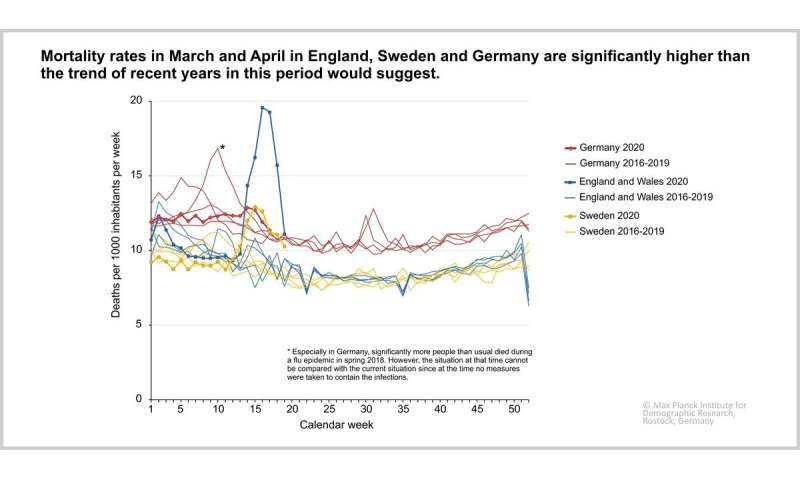
Weekly death countscan be used to calculate how many more people are currently dying during the COVID-19 pandemic than would be expected according to trends in recent years. Internationally, there are clear differences: While in England the death counts in March and April were almost twice as high as in the previous five years, and in Sweden significantly more people died than in the comparable months of the previous years, the increase in Germany is moderate. However, all three countries seem to be past the peak of the curve.
How much does the coronavirus pandemic affect mortality in different countries? This question can best be answered with weekly death counts by gender and age. For 15 countries including Germany, England, Sweden and the U.S., these data are now publicly available in the Human Mortality Database, the joint project of the Max Planck Institute for Demographic Research in Rostock and the University of California, Berkeley. The data for other countries will be published over the course of the year.
“Weekly death counts are a reasonable way of comparing excess mortality between different countries,” says Dmitri Jdanov, head of the data laboratory at the Max Planck Institute who also has shared responsibility for the Human Mortality Database. This is because these data do not depend on how many people in a country are tested for COVID-19 or how a COVID-19 death is defined, which also varies from country to country.
Germany has come through the crisis relatively unscathed by international comparison. “But this only applies as long as we do not experience a second wave of infection,” Dmitri Jdanov concludes.
At the peak of the pandemic, more than 22,000 people died in England and Wales during calendar week 16, in the middle of April. In the previous five years, the death count was between 9,000 and 11,000 people in that same calendar week. In Sweden, the peak began at the same time with around 2,500 deaths which was about 70 percent higher than the five-year trend of about 1,700 deaths.
In Germany, the weekly death counts in March and April were also higher than the trend of recent years would suggest. However, two years ago in spring 2018, even more people died during a serious flu epidemic. “I want to emphasize that that flu epidemic is not comparable with the current situation. Never before have there been such strong countermeasures to contain the infections. Moreover, we do not know how many people were infected with the flu in 2018. It is therefore impossible to calculate the percentage of deaths,” warns Dmitri Jdanov.
Source: Read Full Article
